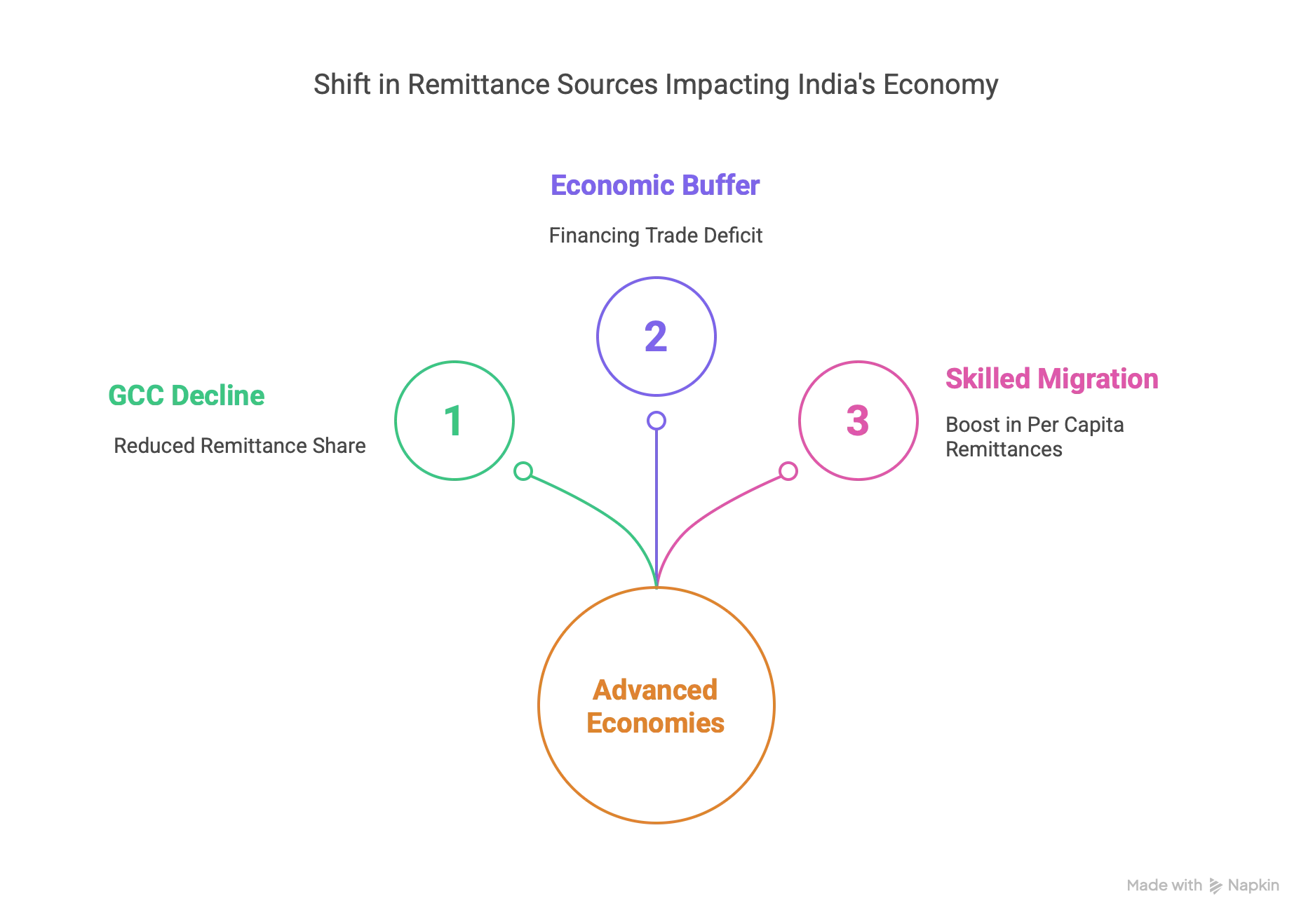Shifting Remittance Patterns: India’s Economic Transition
Last Updated
5th April, 2025
Date Published
5th April, 2025
Share This Post With Someone

India, the world’s top recipient of remittances, is witnessing a significant shift in the sources of these inflows, as highlighted in an article from The Indian Express dated April 4, 2025. Traditionally dominated by Gulf Cooperation Council (GCC) countries, remittances are increasingly flowing from advanced economies (AEs) like the US, UK, and Singapore. This transition reflects evolving migration patterns, economic policies, and global trends, offering key insights into India’s diaspora, economic resilience, and policy challenges for aspirants preparing for competitive examinations focusing on economy and international relations.

Key Points:
Shift in Remittance Sources:
- Dominance of Advanced Economies: In 2023-24, AEs (US, UK, Singapore, Canada, Australia) contributed over 50% of India’s remittances, surpassing the GCC countries, a historic shift from Gulf dominance.
- GCC Decline: The GCC share dropped to 38%, with UAE falling from 26.9% (2016-17) to 19.2% (2023-24), Saudi Arabia from 11.6% to 6.7%, and Kuwait from 6.5% to 3.9%.
- US Leadership: The US leads with a 27.7% share in 2023-24 (up from 23.4% in 2020-21), followed by UAE (19.2%) and UK (10.8%, up from 6.8%).
Economic and Migration Drivers:
- GCC Challenges: Post-Covid economic downturns, job losses, salary cuts, and “nationalisation” policies (e.g., Saudisation) reduced opportunities for Indian workers, lowering remittances.
- AE Advantages: Higher wages, stronger currencies (e.g., US dollar), and a growing skilled Indian diaspora in STEM, finance, and healthcare in AEs boost per capita remittances despite fewer migrants compared to GCC.
- Student Migration: Rising numbers of Indian students in AEs (e.g., 32% in Canada, 25.3% in the US in 2024) contribute via loan repayments and post-study employment.
Scale and Impact:
- Record Inflows: India’s remittances doubled from $55.6 billion (2010-11) to $118.7 billion (2023-24), financing nearly half the merchandise trade deficit and acting as a buffer against external shocks.
- State Distribution: Maharashtra (20.5%), Kerala (19.7%), and Tamil Nadu (10.4%) lead recipients, with Telangana (8.1%) and Karnataka (7.7%) rising due to student and professional migration.
Global Trends and Policy Implications:
- Right-Wing Politics: Restrictive immigration policies in AEs may limit residency, prompting migrants to remit more homeward rather than invest locally, mirroring Gulf worker behavior.
- Research Gaps: Limited data on India-Germany, India-Austria, and India-Netherlands corridors highlights the need for further study on AE contributions.
- Policy Needs: Skill harmonization and mobility agreements with AEs are critical to sustain this shift, ensuring Indian workers remain competitive globally.
Future Outlook:
- Potential Growth: US remittances could rise further under current policies, while GCC inflows may rebound with economic normalization.
- Strategic Shift: The move from blue-collar Gulf jobs to white-collar AE roles reflects India’s evolving workforce and economic priorities.
Glossary
- Remittances: Money sent by migrants to their home country, a key economic lifeline.
- GCC: Gulf Cooperation Council (UAE, Saudi Arabia, etc.), traditional hub for Indian migrant workers.
- Advanced Economies (AEs): High-income nations like the US, UK, offering skilled job opportunities.
- Saudisation: Saudi policy prioritizing local employment, reducing foreign worker roles.
- Diaspora: Indian communities abroad, driving remittance flows.
- Trade Deficit: Gap between imports and exports, partly offset by remittances.
- Skill Harmonisation: Aligning Indian skills with global job demands for better mobility.
Link To The Original Article – https://indianexpress.com/article/explained/why-india-is-getting-more-remittances-from-advanced-economies-than-the-gulf-9925685/